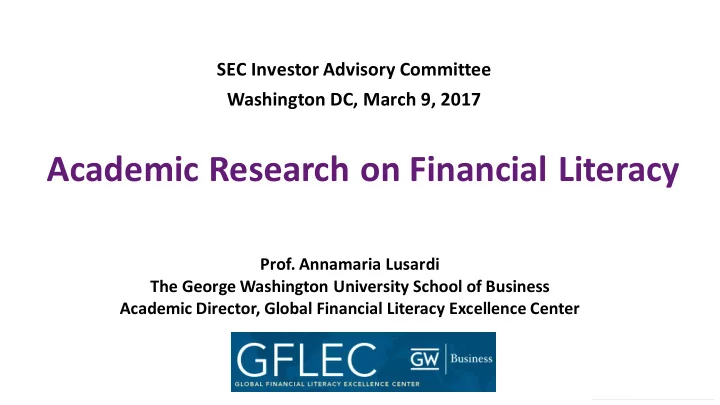

SEC Investor Advisory Committee Washington DC, March 9, 2017 Academic Research on Financial Literacy Prof. Annamaria Lusardi The George Washington University School of Business Academic Director, Global Financial Literacy Excellence Center
Investors need basic financial knowledge • Big 3 questions: Numeracy/interest rate • Inflation • Risk diversification • • Being financially literate : How many can answer these 3 questions correctly? • These 3 questions have been used in 15 countries: Financial Literacy around the World (FLAT World) project
Financial literacy over time in the US % of people correctly answering big 3 questions 45% 39% 40% 34% 35% 32% 30% 25% 20% 15% 10% 5% 0% 2009 2012 2015 Source: 2009, 2012, 2015 NFCS data Financial knowledge did not increase since 2009 •
Financial literacy by age in the US (% answering Big 3 questions correctly) 60% 51% 50% 47% 44% 42% 38% 40% 37% 36% 35% 27% 30% 24% 18% 20% 13% 10% 0% 18-24 25-29 30-34 35-39 40-44 45-49 50-54 55-59 60-64 65-69 70-74 75+ Source: 2015 NFCS data Financial knowledge increases very slowly with age • Less than 1/3 know 3 basic questions by age 40 even though most • important decisions are made well before that age
Risk is the most difficult concept to grasp Correct Incorrect Don't know 75% 13% 12% Interest rate question Inflation question 59% 20% 20% Risk question 46% 10% 44% Source: 2015 NFCS data • “Do not know” responses to risk diversification question are dramatically high • Our recent data from 10 European countries shows that risk-related concepts are the least understood
Financial literacy among investors % of correct answers 90% 83% 83% 75% 80% 71% 69% 65% 70% 60% 59% 60% 46% 50% 40% 30% 20% 10% 0% Interest rate question Inflation question Risk question General population Investors People with investments or self-directed retirement account Source: 2015 NFCS data • Financial knowledge is not much higher among investors • Only 1 in 2 investors answer correctly 3 basic questions
Financial sophistication • More complex questions were asked in other surveys, for example: Assets pricing • Knowledge of sophisticated concepts is lower E.g., 43% of investors have assets pricing knowledge • Economic/finance jargon is not understood “Don’t know” responses increase when jargon is used Especially important for women
Mismatch between actual and perceived financial knowledge 100% 90% 87% 90% 76% 80% 70% 60% 51% 47% 50% 40% 32% 30% 20% 10% 0% General population Investors People with investments or self- directed retirement account Basic financial literacy High perception of financial knowledge Source: 2015 NFCS data • Despite low levels of financial literacy, Americans have high self-perceptions of their financial knowledge • The mismatch is high among investors too
Implications from academic research • Need to step up the effort on financial education Important to prepare the next generation of investors • Because risk is particularly difficult to grasp, visualization or other strategies may help • Different strategies to communicate with investors Keep the message free of complex terminology More targeted messages to population subgroups
Contact and further information Annamaria Lusardi Global Financial Literacy Excellence Center (GFLEC) E-mail: alusardi@gwu.edu Webpage: www.gflec.org Twitter: @A_Lusardi WSJ blog : http://blogs.wsj.com/experts/tag/annamaria-lusardi/
Recommend
More recommend